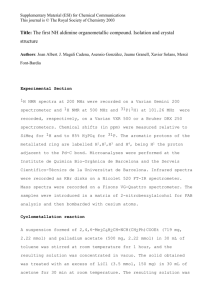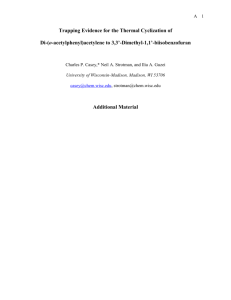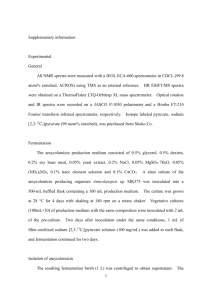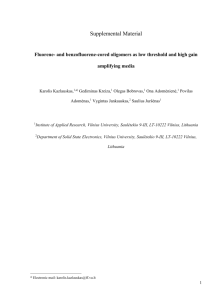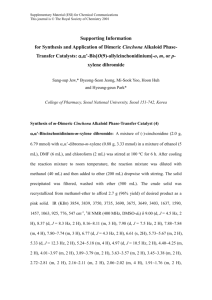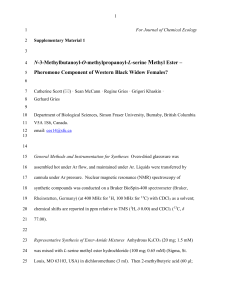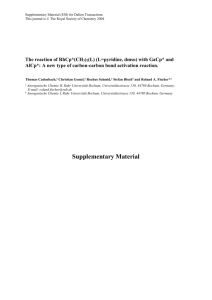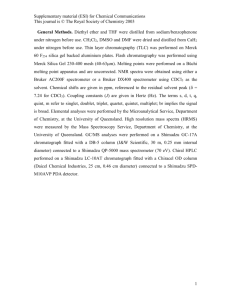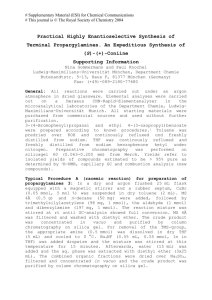Experimental section - Royal Society of Chemistry
advertisement
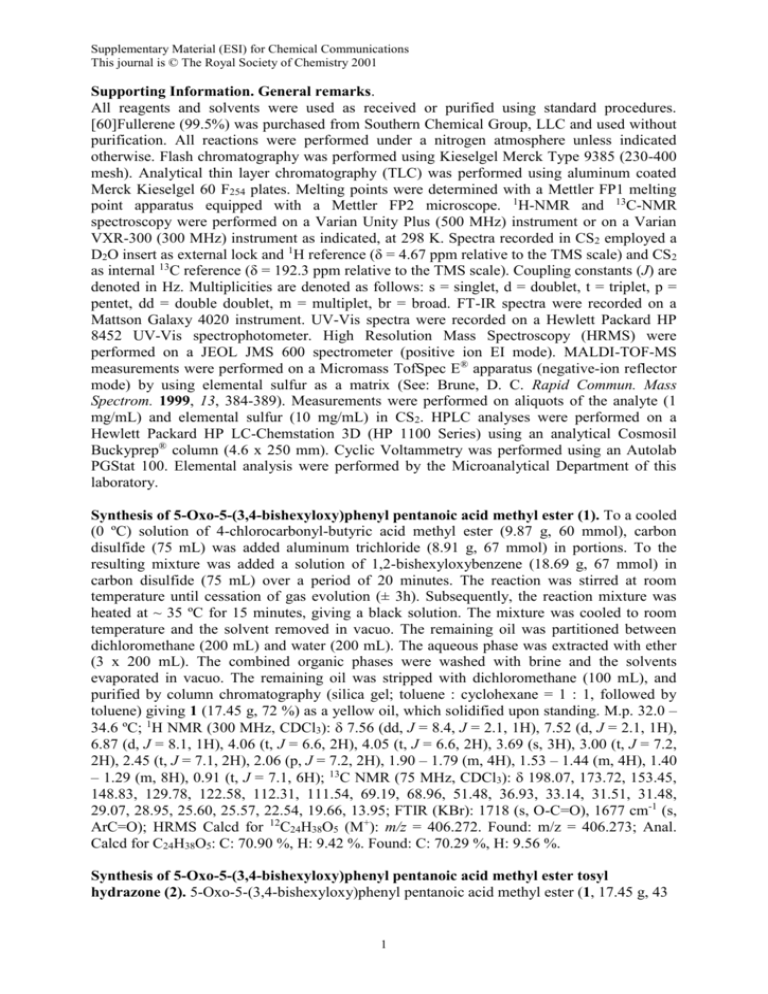
Supplementary Material (ESI) for Chemical Communications This journal is © The Royal Society of Chemistry 2001 Supporting Information. General remarks. All reagents and solvents were used as received or purified using standard procedures. [60]Fullerene (99.5%) was purchased from Southern Chemical Group, LLC and used without purification. All reactions were performed under a nitrogen atmosphere unless indicated otherwise. Flash chromatography was performed using Kieselgel Merck Type 9385 (230-400 mesh). Analytical thin layer chromatography (TLC) was performed using aluminum coated Merck Kieselgel 60 F254 plates. Melting points were determined with a Mettler FP1 melting point apparatus equipped with a Mettler FP2 microscope. 1H-NMR and 13C-NMR spectroscopy were performed on a Varian Unity Plus (500 MHz) instrument or on a Varian VXR-300 (300 MHz) instrument as indicated, at 298 K. Spectra recorded in CS2 employed a D2O insert as external lock and 1H reference (δ = 4.67 ppm relative to the TMS scale) and CS2 as internal 13C reference (δ = 192.3 ppm relative to the TMS scale). Coupling constants (J) are denoted in Hz. Multiplicities are denoted as follows: s = singlet, d = doublet, t = triplet, p = pentet, dd = double doublet, m = multiplet, br = broad. FT-IR spectra were recorded on a Mattson Galaxy 4020 instrument. UV-Vis spectra were recorded on a Hewlett Packard HP 8452 UV-Vis spectrophotometer. High Resolution Mass Spectroscopy (HRMS) were performed on a JEOL JMS 600 spectrometer (positive ion EI mode). MALDI-TOF-MS measurements were performed on a Micromass TofSpec E® apparatus (negative-ion reflector mode) by using elemental sulfur as a matrix (See: Brune, D. C. Rapid Commun. Mass Spectrom. 1999, 13, 384-389). Measurements were performed on aliquots of the analyte (1 mg/mL) and elemental sulfur (10 mg/mL) in CS2. HPLC analyses were performed on a Hewlett Packard HP LC-Chemstation 3D (HP 1100 Series) using an analytical Cosmosil Buckyprep® column (4.6 x 250 mm). Cyclic Voltammetry was performed using an Autolab PGStat 100. Elemental analysis were performed by the Microanalytical Department of this laboratory. Synthesis of 5-Oxo-5-(3,4-bishexyloxy)phenyl pentanoic acid methyl ester (1). To a cooled (0 ºC) solution of 4-chlorocarbonyl-butyric acid methyl ester (9.87 g, 60 mmol), carbon disulfide (75 mL) was added aluminum trichloride (8.91 g, 67 mmol) in portions. To the resulting mixture was added a solution of 1,2-bishexyloxybenzene (18.69 g, 67 mmol) in carbon disulfide (75 mL) over a period of 20 minutes. The reaction was stirred at room temperature until cessation of gas evolution (± 3h). Subsequently, the reaction mixture was heated at ~ 35 ºC for 15 minutes, giving a black solution. The mixture was cooled to room temperature and the solvent removed in vacuo. The remaining oil was partitioned between dichloromethane (200 mL) and water (200 mL). The aqueous phase was extracted with ether (3 x 200 mL). The combined organic phases were washed with brine and the solvents evaporated in vacuo. The remaining oil was stripped with dichloromethane (100 mL), and purified by column chromatography (silica gel; toluene : cyclohexane = 1 : 1, followed by toluene) giving 1 (17.45 g, 72 %) as a yellow oil, which solidified upon standing. M.p. 32.0 – 34.6 ºC; 1H NMR (300 MHz, CDCl3): 7.56 (dd, J = 8.4, J = 2.1, 1H), 7.52 (d, J = 2.1, 1H), 6.87 (d, J = 8.1, 1H), 4.06 (t, J = 6.6, 2H), 4.05 (t, J = 6.6, 2H), 3.69 (s, 3H), 3.00 (t, J = 7.2, 2H), 2.45 (t, J = 7.1, 2H), 2.06 (p, J = 7.2, 2H), 1.90 – 1.79 (m, 4H), 1.53 – 1.44 (m, 4H), 1.40 – 1.29 (m, 8H), 0.91 (t, J = 7.1, 6H); 13C NMR (75 MHz, CDCl3): 198.07, 173.72, 153.45, 148.83, 129.78, 122.58, 112.31, 111.54, 69.19, 68.96, 51.48, 36.93, 33.14, 31.51, 31.48, 29.07, 28.95, 25.60, 25.57, 22.54, 19.66, 13.95; FTIR (KBr): 1718 (s, O-C=O), 1677 cm-1 (s, ArC=O); HRMS Calcd for 12C24H38O5 (M+): m/z = 406.272. Found: m/z = 406.273; Anal. Calcd for C24H38O5: C: 70.90 %, H: 9.42 %. Found: C: 70.29 %, H: 9.56 %. Synthesis of 5-Oxo-5-(3,4-bishexyloxy)phenyl pentanoic acid methyl ester tosyl hydrazone (2). 5-Oxo-5-(3,4-bishexyloxy)phenyl pentanoic acid methyl ester (1, 17.45 g, 43 1 Supplementary Material (ESI) for Chemical Communications This journal is © The Royal Society of Chemistry 2001 mmol) and para-tosylhydrazide (25.8 g, 139 mmol, 3.2 eq.) were dissolved in methanol. The mixture was heated under reflux until TLC (silica gel; chloroform) showed complete conversion of the starting material (± 5.5 h). The mixture, diluted to a total of 200 mL with methanol, was left to crystallize overnight. Filtration, washing with cold methanol (50 mL) and drying gave pure 2 (14.2 g, 61 %) as a white solid. M.p.: 82.4 – 83.2 C; 1H NMR (300 MHz, CDCl3): 8.98 (s, 1H), 7.92 (d, J = 8.4, 2H), 7.30 (d, J = 2.1, 1H), 7.28 (d, J = 8.4, 2H), 7.08 (dd, J = 8.4, 2.4, 1H), 6.79 (d, J = 8.7, 1H), 4.03 - 3.97 (m, 4H), 3.81 (s, 3H), 2.62 – 2.57 (m, 2H), 2.41 (s, 3H), 2.34 – 2.30 (m, 2H), 1.87 – 1.77 (m, 4H), 1.72 – 1.61 (m, 2H), 1.53 – 1.44 (m, 4H), 1.41 – 1.32 (m, 8H), 0.95 – 0.88 (m, 6H); 13C NMR (75 MHz, CDCl3): 174.59, 153.91, 150.65, 148.86, 143.61, 135.96, 129.32, 128.82, 128.00, 119.32, 112.43, 111.41, 69.09, 69.01, 52.21, 32.11, 31.56, 31.49, 29.20, 29.05, 25.72, 25.63, 25.59, 22.58, 22.53, 21.51, 21.10, 13.98; FTIR (KBr): 3220 (s, NH), 1731 cm-1 (s, C=N); HRMS: Calcd for 12 C31H46N2O6S (M+): m/z = 574.308. Found: m/z = 574.309; Anal. Calcd for C31H46N2O6S: C: 64.78 %, H: 8.07 %, N: 4.87 %, S: 5.58 %. Found: C: 64.60 %, H: 8.37 %, N: 4.89 %, S: 5.58 %. Synthesis of methanofullerene butyric acid 4. Tosyl hydrazone 2 (1.91 g, 3.33 mmol) was dissolved in anhydrous pyridine (45 mL) and sodium methoxide (178 mg, 3.30 mmol) was added. The mixture was stirred for 30 minutes at room temperature and subsequently a solution of [60]fullerene (2.16 g, 3.00 mmol) in ortho-dichlorobenzene (ODCB, 150 mL) was added. The mixture was stirred at 80-90 ºC for 16 h. After cooling to room temperature the solvent was removed in vacuo. The residual solid was redissolved in ODCB (200 mL) and irradiated with a 500 W sodium flood lamp for 100 minutes. HPLC (toluene : cyclohexane = 1 : 1) showed complete conversion to the methanofullerene butyric methyl ester 3b. After removal of the solvent in vacuo the residue was redissolved in toluene (300 mL). After addition of acetic acid (180 ml), concentrated hydrochloric acid (75 mL) and water (2.5 mL), the mixture was stirred and heated under reflux for 16 h. HPLC-analysis (toluene : cyclohexane = 1 : 1) showed approximately 60 % conversion of 3b to 4. Another portion of hydrochloric acid (225 mL, concentrated) was added and the mixture was heated under reflux for another night. HPLC (toluene : cyclohexane = 1 : 1) showed 80 % conversion. After cooling to room temperature the colorless aqueous layer was discarded, and the organic phase was washed with water (2 x 300 mL). The solvents were removed in vacuo, and the residue was purified by column chromatography (silica gel: carbon disulfide) to yield unreacted [60]fullerene. Subsequent elution with toluene gave ester 3b, and final elution with toluene : ethyl acetate = 9 : 1 gave acid 4. The independent reaction products were dissolved in ODCB, precipitated with methanol, washed with methanol (2 x), and finally dried in vacuo overnight (T = 50 ºC) yielding [60]fullerene (837 mg, 1.16 mmol, 39 %), 3b (250 mg, 0.23 mmol, 7.5 %) and 4 (1.182 g, 1.08 mmol, 36 %). 3b: M.p.: 92.8 – 93.8 C; 1H NMR (500 MHz, CDCl3): 7.41 (dd, J = 8.3, J = 2.0, 1H), 7.38 (d, J = 2.0, 1H), 7.00 (d, J = 8.3, 1H), 4.09 (m, 4H), 3.68 (s, 3H), 2.88 (m, 2H), 2.53 (t, J = 7.6), 2.19 (m, 2H), 1.88 (m, 2H), 1.81 (m, 2H), 1.50 (m, 2H), 1.38 (m, 4H), 1.33 (m, 4H), 0.92 (t, J = 7.1), 0.89 (t, J = 7.1). 13 C NMR (500 MHz, CDCl3): 173.38, 149.04, 148.78, 148.19, 147.81, 145.76, 145.05, 145.03, 145.00, 144.91, 144.86, 144.66, 144.63, 144.59, 144.50, 144.35, 144.26, 143.85, 143.63, 143.62, 142.97, 142.87, 142.85, 142.78, 142.75, 142.11, 142.07, 141.98, 141.97, 140.79, 140.56, 137.86, 137.66, 128.57, 125.15, 118.04, 112.67, 80.14, 69.60, 68.94, 51.62, 51.58, 33.84, 33.58, 31.61, 31.56, 29.25, 29.21, 25.72, 25.63, 22.56, 22.43, 13.98. FTIR (KBr): 1737 (s, C=O), 1249 (s, ArOR), 526 cm-1 (s, methanofullerene); UV-VIS (chloroform, λ (ε)): 331 (53700), 433 (2920), 485 (1810), 698 (276); MALDI-TOF MS: Calcd for 12C84H38O4 (M-): m/z = 1110.3. Found: m/z = 1110.5; Anal. Calcd for C84H38O4: C: 90.79 %, H: 3.45 %. Found: C: 90.50 %, H: 3.55 %; 4: M.p.: 132.5 – 133.2 C; 1H NMR (500 MHz, 2 Supplementary Material (ESI) for Chemical Communications This journal is © The Royal Society of Chemistry 2001 CDCl3): 7.40 (dd, J = 8.3, 2.0, 1H), 7.38 (d, J = 2.0), 7.00 (d, J = 8.3, 1H), 4.09 (m, 4H), 2.90 (br m, 2H), 2.57 (br t, 2H), 2.20 (br m, 2H), 1.88 (m, 2H), 1.81 (m, 2H), 1.50 (m, 2H), 1.38 (m, 4H), 1.33 (m, 4H), 0.92 (t, J = 7.2, 3H), 0.89 (t, J = 7.2, 3H); 13C NMR (125, MHz, CS2): 179.08, 149.25, 148.70, 148.46, 147.52, 145.61, 145.00, 144.97, 144.94, 144.90, 144.77, 144.60, 144.55, 144.43, 144.27, 144.25, 143.91, 143.58, 143.54, 142.89, 142.84, 142.82, 142.75, 142.72, 142.02, 141.95, 141.94, 140.82, 140.56, 137.87, 137.71, 128.06, 124.88, 117.30, 112.66, 79.73, 69.18, 68.72, 51.52, 33.79 , 33.59, 32.07, 32.05, 29.87, 26.32, 26.22, 23.31, 23.29, 22.49, 14.61; FTIR (KBr): 3495 (br m, OH), 1705 (s, C=O), 526 cm-1 (s, methanofullerene); UV-VIS (toluene, λ (ε)): 331 (44900), 433 (2990), 490 (1850), 699 (311); MALDI-TOF MS: Calcd for 12C83H36O4 (M-): m/z = 1096.3. Found: m/z = 1096.1; Anal. Calcd for C83H36O4: C: 90.86 %, H: 3.31 %. Found: C: 90.77 %, H: 3.44 %. Synthesis quadruple hydrogen bonding fullerene derivative 8. Acid 4 (548 mg, 0.50 mmol) was dissolved in chloroform (25 mL), and thionyl chloride (2.5 mL) was added. The resulting mixture was heated under reflux for 1 h. After cooling to room temperature the volatiles were removed in vacuo. The remaining solid was redissolved in ODCB (10 mL) and N,N-dimethyl acetamide (10 mL) and sodium azide (62 mg, 0.95 mmol) was added. The resulting mixture was stirred at room temperature and progress was monitored by TLC (silica gel; chloroform) until maximum conversion was obtained (75 minutes). Subsequently, 2amino-4-hydroxy-6-methylpyrimidine (125 mg, 1.00 mmol) and anhydrous pyridine (10 mL) were added and the reaction mixture was heated to 70 – 80 ºC for 2 h), after which TLC (silica gel; chloroform) showed complete conversion of the starting material. After cooling to room temperature the mixture was partitioned between dichloromethane (200 mL) and water (200 mL). The organic phase was washed with water (200 mL), concentrated in vacuo, and the residue was purified by column chromatography (silica gel; chloroform, Rf ≈ 0.2). The obtained product was suspended in, and precipitated from methanol (3 x) and dried overnight at ~ 50 ºC in vacuo, giving crude product 8 (465 mg, 382 μmol, 76 %, 98+ % pure). Final purification was obtained by two successive columns (silica gel; dichloromethane : ethyl acetate = 19 : 1, followed by silica gel; chloroform). The obtained product was suspended and centrifuged from subsequently toluene, ether and methanol giving material suitable for elemental analysis. M.p.: > 200 C; 1H NMR (500 MHz, CDCl3): 12.99 (s, 1H), 11.81 (s, 1H), 10.40 (t, J = 5.3, 1H), 7.40 (dd, J = 8.3, J = 2.3, 1H), 7.37 (d, J = 2.5, 1H), 6.99 (d, J = 8.5, 1H), 5.75 (s, 1H), 4.08 (t, J = 6.8, 4H), 3.49 – 3.43 (m, 2H), 2.98 – 2.92 (m, 2H), 2.24 – 2.15 (m, 5H), 1.88 (p, J = 7.0, 2H), 1.81 (p, J = 7.1, 2H), 1.56 –1.45 (m, 4H), 1.41 – 1.37 (m, 4H), 1.35 – 1.31 (m, 8H), 0.94 - 0.88 (m, 6H); 13C NMR (125 MHz, CDCl3): 172.84, 156.56, 154.48, 149.01, 148.93, 148.26, 148.17, 147.97, 145.97, 145.08, 145.05, 144.98, 144.97, 144.71, 144.69, 144.52, 144.44, 144.36, 143.88, 143.67, 143.55, 142.95, 142.93, 142.89, 142.86, 142.79, 142.71, 142.17, 142.06, 142.00, 141.95, 140.61, 140.50, 137.90, 137.73, 128.99, 125.08, 117.93, 112.73, 106.78, 80.56, 69.62, 69.02, 52.39, 39.47, 31.74, 31.66, 31.56, 29.36, 27.43, 25.82, 25.76, 22.65, 18.96, 14.09; FTIR (KBr): ~ 3440 (m, N-H), 1695 (m, C=O), 1658 (s, NHC=ONH), 1586 and 1513 (s, C=N and C=C), 1248 (s, ArOR), 526 cm-1 (s, methanofullerene); UV-VIS (chloroform, λ (ε)): 329 (37100), 432 (3170), 698 (245); MALDI-TOF MS: Calcd for 12C88H42N4O4 (M-): m/z = 1218.3. Found: m/z = 1217.8; Anal. Calcd for C88H42N4O4: C, 86.68; H, 3.47; N, 4.59; Found: C, 86.51; H, 3.38; N, 4.49. Spincoating. Solutions of the polymer MDMO-PPV (1.0 % m/v, filtered through a Millipore Millex-LS 5.0 μm pore size PTFE membrane filter) and hydrogen bonded fullerene derivative 8 (1.0 m/v %, filtered through an Acrodisc CR PTFE 0.45 μm syringe filter) were mixed in a 1 : 4 (v/v) ratio and spincoated on a glass substrate (1250 rpm for 20 s, followed by 3000 rpm for 20 s). The optical quality was determined by sight. 3 Supplementary Material (ESI) for Chemical Communications This journal is © The Royal Society of Chemistry 2001 13 C and 1H NMR of compound 8 in CDCl3 at 25 C 4 Supplementary Material (ESI) for Chemical Communications This journal is © The Royal Society of Chemistry 2001 DHOPCBU(Me)Pyr 0.5 Absorbance (AU), [ ] = 8.06 * 10 -6 Absorbance (AU), [ ] = 1.03 * 10 -4 Absorbance (AU) 0.4 432 (3.17 * 10 3 ) 0.3 329 (3.71 * 10 4 ) 0.2 0.1 698 (2.45 * 10 2 ) 0.0 300 400 500 600 700 800 900 W avelength (nm) UV-Vis spectra (chloroform) of 8. DHOPCPU(Me)Pyr 100 Transmission (% ) 90 approx. 3440 80 1695 70 526 1658 60 1248 1586 50 4000 3500 3000 2500 2000 1500 W avenumber (cm -1 ) FTIR-spectrum (KBr) of 8. 5 1000 500 Supplementary Material (ESI) for Chemical Communications This journal is © The Royal Society of Chemistry 2001 100.00 1217.8 80.00 1210 1215 1220 1225 1230 % 60.00 40.00 20.00 0.00 800 1000 1200 1400 m/z MALDI-TOF spectrum (negative mode, CS2/S8) of 8. -2.0x10 -5 -1.6x10 -5 I (A) -1.2x10 -5 -8.0x10 -6 -4.0x10 -6 0.0 4.0x10 -6 0.0 -0.5 -1.0 -1.5 -2.0 E (V) Cyclic Voltammogram of compound 8 in ODCB/MeCN (4/1) at 100 mV/s 6 -2.5


